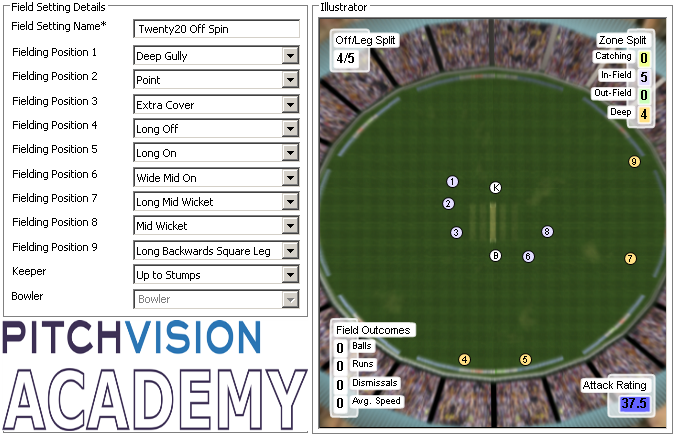Field setting: Off spin, Twenty20 middle overs (IPL special)
 This article is part of "The complete guide to cricket field settings" series.
This article is part of "The complete guide to cricket field settings" series.
Don't make this mistake in the opening overs
Power plays are a terrible invention.
They make IPL games more fun to watch when Tendulkar and Jayasuriya are flailing it to all parts.
But the whole idea seems so contrived and, well... restricted (at least to a declaration loving traditionalist like me).
Nevertheless, as my own (50 over) league has brought in a fielding circle this season and it's a staple of Twenty20 cricket at every level, it's time to look how the pros do it.
How to exploit batting weaknesses: Width of stance
This is part of a series on How to exploit batsman's weaknesses. To see the other weaknesses click here.
Every good coach will tell their players to stand ready with their feet a comfortable distance apart. While this is usually about shoulder width, some players will stand differently.
How to exploit batting weaknesses: Choking grip
This is part of a series on How to exploit batsman's weaknesses. To see the other weaknesses click here.
If you are looking for batting weaknesses, it's best not to highlight a technique used by Don Bradman. So just to be awkward, that's exactly what I'm about to do.
The 'choked' or 'O' grip is a common variation of the more orthodox bottom hand grip and, despite the example of the Don, causes problems for batsman at club and school level.
Ask the Readers: What's your perfect batting order?
 How do you pick your batting order?
How do you pick your batting order?Do you flout convention? Do you put giving everybody a go above winning the match? Or vice versa?
There are a number of things to consider:
How to exploit batting weaknesses: Open stance
This is part of a series on How to exploit batsman's weaknesses. To see the other weaknesses click here.
On the surface, an open stance is an excellent way to play. It gives the batsman a balanced position from which he or she has a wide range of scoring options.
But it can also lead to their downfall, if you know how to read it properly.
How to exploit batting weaknesses: Closed off stance
This is part of a series on How to exploit batsman's weaknesses. To see the other weaknesses click here.
A "closed off" stance is one of the easiest weaknesses to spot and exploit because the batsman reveals his hand before he has even faced a ball.
It's also very common in club cricket. At the level I play I see it every weekend at least once, especially with lower order and tail-end batsmen.
How to exploit batting weaknesses: Introduction
In cricket, all batsmen have technical weaknesses. Really good bowlers and captains are able to use them to get the player out.
In this new series we will examine the more common technical faults, show you how to spot them and give you the bowling and field setting tactics you need to exploit them.
So if you are a bowler or a captain and you find yourself scratching your head for ideas on how to get a player out, this is the guide for you.
Warning: Thinking can seriously hurt your cricket
Who wouldn't want to be streetwise with thoughts and plans at their fingertips?
Raj is an opening batsman. He is a slow starter, but is able to score freely once he gets his feet moving. His coach has been helping him with some technical points.
Meanwhile his team-mates have been teasing him for his slow starts.
What happened at the coaching conference?
 Knowledge is a tool used by coaches to make better cricketers.
Knowledge is a tool used by coaches to make better cricketers.
That's why the ECBCA conference is such an important event for all coaches: You surround yourself with such passionate and knowledgeable people, all of whom love sharing their knowledge of the game.

